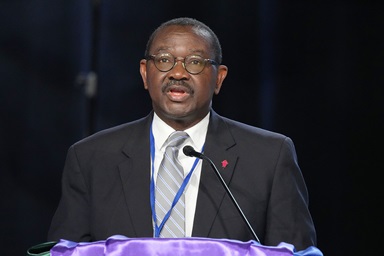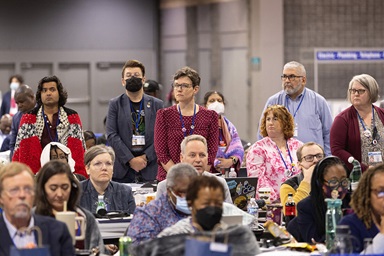General Conference 2008 honored men and women who worked 40 years ago for the end of a separate Central Jurisdiction for black Methodists and who sacrificed to integrate The United Methodist Church.
"We honor you today for your life witness and your stand as an ambassador of justice and reconciliation in the church," said Erin Hawkins, chief executive of the United Methodist Commission on Religion and Race.
Hawkins led the April 27 celebration of the dissolution of the Central Jurisdiction, which was formed in 1939 as a segregated place for black Methodists in the merger of the Methodist Protestant Church, the Methodist Episcopal Church and the Methodist Episcopal Church, South. It was dissolved in 1968 as part of the union of The Methodist Church and The Evangelical United Brethren Church that established The United Methodist Church and formed the five current geographic jurisdictions in the United States.
"In honoring the Central Jurisdiction, we acknowledge the advances we have made and the challenges we still face as a church," Hawkins said.
The General Commission on Religion and Race, also formed in 1968, monitored the multiyear process of integrating the annual conferences. Many church members helped with the process despite being ostracized by other members.
"For Methodist blacks, the creation of the racially segregated Central Jurisdiction was a humiliating disappointment," W. Astor Kirk told General Conference delegates. He was a member of the Committee of Five, which sought the dissolution of the Central Jurisdiction.
However, Kirk said, "many resourceful men and women used the organization as an instrument for empowering Methodist blacks."
With the dissolution of the Central Jurisdiction, black Methodists developed a plan for lobbying and presenting resolutions, including facilitating the creation of the Commission on Religion and Race. They also formed Black Methodists for Church Renewal Inc., which launched initiatives such as the Black College Fund, Strengthening the Black Church for the 21st Century and the African-American United Methodist Heritage Center.
"The merger ... in 1968, which eliminated the principle of mandatory segregation in the church known as the Central Jurisdiction, was an essential step which paved the way for The United Methodist Church today to continue battling its demons of privilege, prejudice and racism," said Angella Current-Felder, an executive staff member of the United Methodist Board of Higher Education and Ministry.
At the celebration, she introduced herself as a fourth generation Methodist and the daughter of the denomination's first female African-American bishop, Leontine Turpeau Current Kelly, and the late Rev. Gloster Bryant Current of the New York Conference. "My mother has often declared, 'Racism has no business in the church of Jesus Christ,'" Current-Felder said.
But she added that "without the memory of the Central Jurisdiction, we cannot know that it is possible to overcome a legacy of hatred and exclusion and move toward unity in Christ Jesus."
Bishop Forrest C. Stith, retired and chair of the African-American Methodist Heritage Center, said, "We especially grieve that in 1939 hundreds of thousands of African Americans were marginalized. &ellipsis; We are thankful for thousands of African Americans who chose to stay in the church."
Today there are about 500,000 African-American U.S. members of The United Methodist Church, including 12 bishops and more than 2,400 predominantly black congregations.
Earlier in the day, General Conference 2008 approved funding of $100,000 per year in 2009-2012 for the African-American Methodist Heritage Center. Created by the 2004 General Conference, the center gathers stories, artifacts and other historical items of African-American Methodists from the mid-18th century to the present.
Many concerns still remain today for African Americans and other people of color, Hawkins said. They include:
- Equity in compensation between clergy of color and white clergy has not yet been realized;
- Annual conference nomination committees still disproportionately recommend lay and clergy leaders of color to serve in ministries related to ethnic and social concerns;
- The itinerancy system continues to be a source of much institutional racism within the church; and
- Even after 40 years of integration, people of color are but one group still seeking full inclusion in the life of the church.
Closing the celebration, Stith prayed, "Now we remember, reflect and rededicate our lives as we praise you, oh God, for it was 40 years ago that our Methodist Church crossed the difficult divide in a series of decisions that eliminated the Central Jurisdiction. Now we boldly move toward the kingdom promised by Jesus Christ, even here on earth."
*White is associate editor of Interpreter magazine.
News media contact: Deborah White, e-mail: newsdesk@umcom.org.
Phone calls can be made to the General Conference Newsroom in Fort Worth, Texas, at (817) 698-4405 (817) 698-4405 until May 3. Afterward, call United Methodist News Service in Nashville, Tenn., at (615) 742-5470
(817) 698-4405 until May 3. Afterward, call United Methodist News Service in Nashville, Tenn., at (615) 742-5470 (615) 742-5470.
(615) 742-5470.
Related Articles
Remembering the Central Jurisdiction, reunion to celebrate history
Resource
Like what you're reading? Support the ministry of UM News! Your support ensures the latest denominational news, dynamic stories and informative articles will continue to connect our global community. Make a tax-deductible donation at ResourceUMC.org/GiveUMCom.




